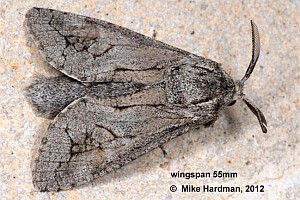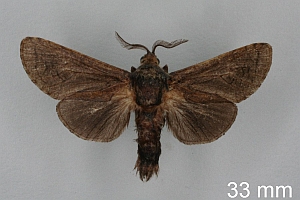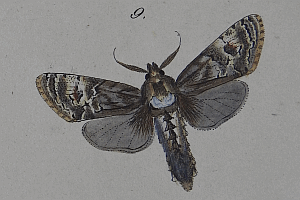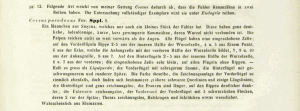

 +5Kontinente:EUAS
+5Kontinente:EUAS1. Lebendfotos
1.1. Falter
2. Diagnose
2.1. Männchen
2.2. Erstbeschreibung
Da diese Tafel binominale Nomenklatur aufweist, ist sie auch ohne weiteren Text als Erstbeschreibung gültig.
Im Folgejahr erschienener Text
3. Biologie
3.1. Nahrung der Raupe
- [Vitaceae:] Vitis vinifera (Weinrebe)
- [Oleaceae:] Olea europaea (Echter Ölbaum, Olivenbaum)
- [Fabaceae:] Vachellia nilotica [= Acacia nilotica, Acacia arabica] (Ägyptischer Schotendorn)
- [Fabaceae:] Albizia lebbeck (Lebbekbaum)
- [Fabaceae:] Cercis siliquastrum (Gewöhnlicher Judasbaum, Judas-Silberling)
- [Moraceae:] Ficus palmata [= Ficus pseudo-sycomorus, Ficus pseudosycomora] (Punjab-Feige)
- [Moraceae:] Ficus carica (Echte Feige)
- [Rosaceae:] Crataegus sp. (Weißdorn)
De Freina & Witt (1990) schreiben: "Die Art entwickelt sich in Stämmen von Oliven, Acacia arabica, Albizia lebbeck, Weinstöcken, Cercis siliquastrum, Crataegus sp., Ficus pseudosycomora u.a."
Plaut (1973) studierte die Biologie der Art beim Befall von Weinreben in Israel. Dort ist zu erfahren: "The biology of Paropta paradoxus (H.-S.), a new pest of the grapevine, was studied in field and laboratory during 1962–1972. [...] In the vineyard eggs are glued under loose bark, in batches of 15.6 (1–63), and hatch in 20–32 days. The neonate larvae disperse and settle under loose bark where they begin feeding; penetration of the wood is mainly through dried stubs of pruned canes, and galleries are excavated along the axes of stems and branches. Larvae may also develop under dry bark. The pest overwinters as active immature larvae and diapausing mature, prepupal larvae. The pupa is usually formed in the larval galleries, and lasts 16–45 days. In heavily infested vines the pupae may be cannibalized by larvae; both larvae and pupae may be preyed on by woodpeckers."
Yakovlev (2010) fasst zusammen: "Host-plants: In Israel Vitis sp. (Plaut, 1965, 1973); in Egypt Ficus carica (Andres & Seitz, 1924); Albizzia lebbek, Ficus pseudosycramorus [sic!] (Wiltshire, 1949). Oliven, Acacia arabica, Cercis siliquastrum, Crataegus sp. (de Freina & Witt, 1990)."
4. Weitere Informationen
4.1. Abweichende Schreibweisen
- Paropta paradoxum [nach dem gender agreement des ICZN gültige Schreibweise]
4.2. Andere Kombinationen
- Cossus paradoxus Herrich-Schäffer, 1851 [Originalkombination]
4.3. Publikationsjahr der Erstbeschreibung
Wir folgen den detaillierten Datierungs-Angaben von Heppner (1982).
4.4. Verbreitung
De Freina & Witt (1990) schreiben zur Gesamtverbreitung der Art: "Südliches Kleinasien über die Levante bis Syrien und Ägypten." Und zum Vorkommen in Europa ist zu erfahren: "Rhodos, vermutlich auch auf weiteren der türkischen Westküste vorgelagerten Inseln." Fritsch et al. (2014) bestätigen diese Vermutung durch einen Nachweis auf Samos im August 2009.
(Autor: Erwin Rennwald)
4.5. Literatur
- de Freina, J.J. & T.J. Witt (1990): Die Bombyces et Sphinges der Westpalaearktis (Insecta, Lepidoptera). Eine umfassende, reich illustrierte und revidierte Gesamtdarstellung der Bombyces und Sphinges Europas und Nordwestafrikas in mehreren Bänden. Band 2. - 140 S.; München (Edition Forschung & Wissenschaft Verlag).
- Fritsch, D., Stangelmaier, G., Top-Jensen, M., Bech, K. (2014): Die nachtaktive Großschmetterlingsfauna von Samos (Griechenland, Östliche Ägäis) (Lepidoptera: Cossoidea, Lasiocampoidea, Bombycoidea, Drepanoidea, Geometroidea, Noctuoidea). — Esperiana. Buchreihe zur Entomologie. Band 19: 7-101. Bad Staffelstein.
- Heppner, J. B. (1982): Dates of selected Lepidoptera literature for the western hemisphere fauna. — Journal of the Lepidopterologists' Society 36 (2): 87-111.
- Erstbeschreibung: Herrich-Schäffer, G. A. W. („1845“) [1843-1855]: Systematische Bearbeitung der Schmetterlinge von Europa, zugleich als Text, Revision und Supplement zu Jakob Hübner's Sammlung europäischer Schmetterlinge. Zweiter Band. Die Schwärmer, Spinner und Eulen: 1-450, Index 1-64, Hepialides pl. 1, Cossides pl. 1-2, Zygaenides pl. 1-16, Sesiides pl. 1-10, Sphingides pl. 1-4, Bombycides pl. 1-32, Noctuides pl. 1-124, Nycteolidae pl. 1. Regensburg.
- Herrich-Schäffer, G. A. W. (1843-1856): Systematische Bearbeitung der Schmetterlinge von Europa, zugleich als Text, Revision und Supplement zu Jakob Hübner's Sammlung europäischer Schmetterlinge. Sechster und letzter Band: Schlusswort [4 pp., unpaginiert]; Macrolepidoptera I-XVIII, pl. I-XXII; Microlepidoptera I-VIII, pl. I-XIV; Nachtrag zum ersten Bande 1-178; Systema Lepidopterorum Europae 1-72; Index 1-48. Regensburg (G. J. Manz).
- Plaut, H.N. (1973): On the biology of Paropta paradoxus (H.-S.) (Lep., Cossidae) on grapevine in Israel. — Bulletin of Entomological Research, 63 (2): 237-245. [Abstract auf cambridge.org]
- Yakovlev, R.V. (2010): Cossidae of Israel. — Atalanta 41 (3/4): 465-469. [PDF auf zobodat.at]
- Yakovlev, R. V. & S. Lewandowski (2007): Paropta paradoxus kathikas subspec. nov., a new subspecies of the Genus Paropta from Cyprus (Lepidoptera, Cossidae). — Atalanta 38 (1/2): 217-219 [PDF auf zobodat.at].











